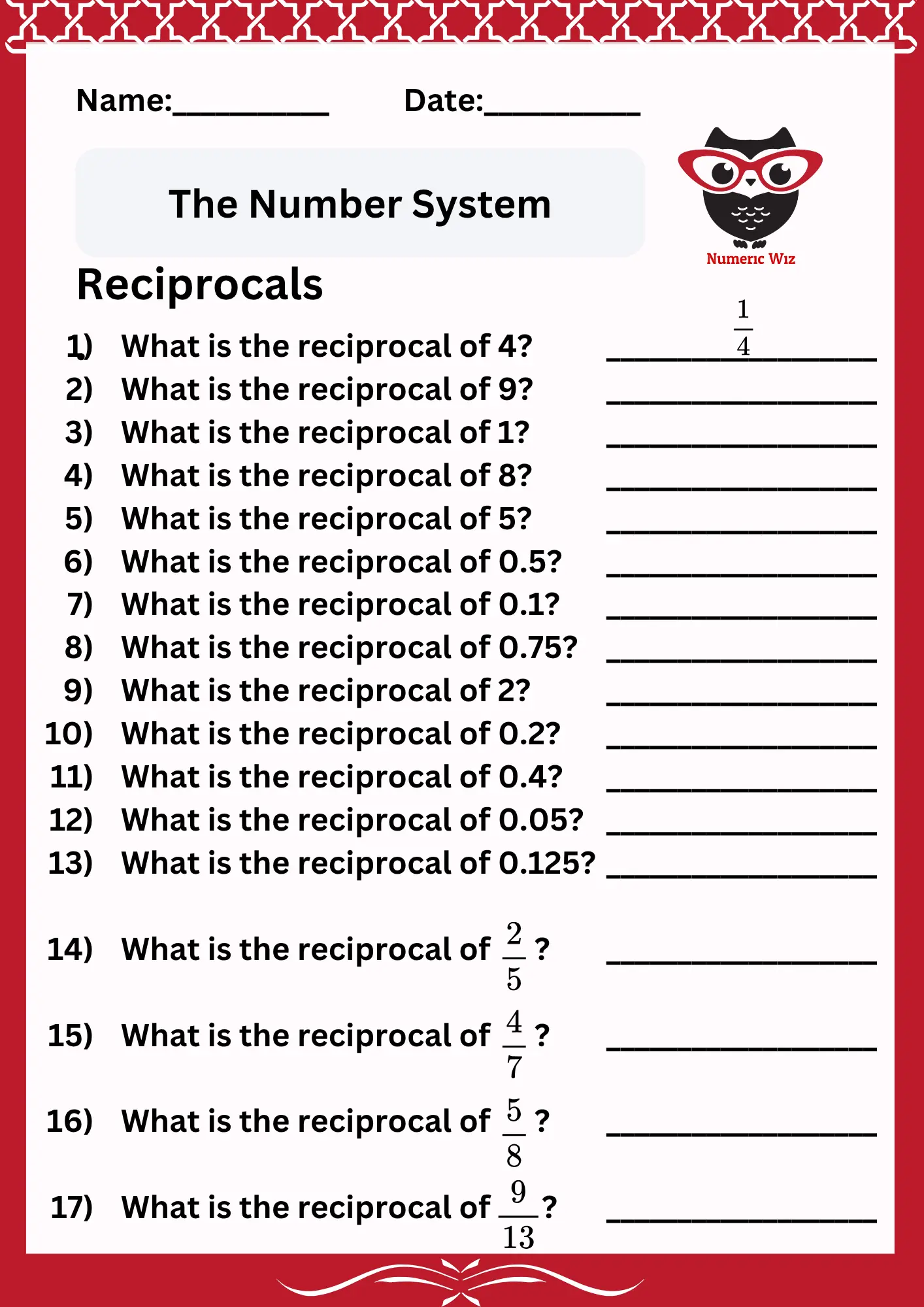Understand what a reciprocal or multiplicative inverse means.
Find the reciprocal of whole numbers, fractions, and mixed numbers.
Verify reciprocals by checking if their product equals 1.
Apply the concept of reciprocals in division and real-world examples

Have you ever seen a fraction flipped upside down and wondered what happened? This worksheet turns that curiosity into confidence! Designed especially for Grade 6 students, it helps you understand the magic behind reciprocals—numbers that, when multiplied together, make one whole.
Reciprocals are everywhere in math. They help us divide fractions, simplify problems, and understand the relationship between numbers. With clear visuals, real-life examples, and easy step-by-step guidance, this worksheet makes learning reciprocals fun and simple.
A reciprocal means “one over the number.” It’s also called the multiplicative inverse because when you multiply a number by its reciprocal, the answer is always 1.
The reciprocal of 2 is 1 over 2
The reciprocal of 3 over 4 is 4 over 3
The reciprocal of 1 over 5 is 5
That’s because: 2 × ![]() = 1, and (
= 1, and (![]() ) × (
) × (![]() ) = 1
) = 1
The word reciprocal comes from the Latin word meaning returning the same way. Historically, merchants and mathematicians used reciprocals to divide numbers quickly—long before calculators existed! Even today, this simple concept helps in finance, science, and algebra.
If you have 5, what is its reciprocal?
Solution:

Write it as 5 over 1, then flip it.
Reciprocal = 1 over 5
Check: 5 ×![]() = 1
= 1
If you have 2 over 3, flip it to get 3 over 2.
Check: (![]() ) × (
) × (![]() ) = 1
) = 1
Reciprocals aren’t just a “flip and forget” trick. They show how multiplication and division are connected. Whenever you divide by a fraction, you’re actually multiplying by its reciprocal.
For example: 6 ÷ ![]() = 6 × 2 = 12
= 6 × 2 = 12
Understanding this helps students work faster, think logically, and solve word problems with ease. For Grade 6 learners, it also builds a strong base for algebra, proportions, and equations they’ll face later on.
Step 1: Identify the number or fraction.
Is it a whole number, fraction, or mixed number?
Step 2: Flip it.
If it’s a fraction, swap the numerator and denominator.
Example:![]() →
→![]()
Step 3: For whole numbers, write them as a fraction over 1, then flip.
Example: 4 = ![]() → reciprocal =
→ reciprocal = ![]()
Step 4: For mixed numbers, change to an improper fraction first, then find the reciprocal.
Example: ![]() =
=![]() → reciprocal =
→ reciprocal = ![]()
Step 5: Check your answer.
Multiply the number and its reciprocal. If you get 1, it’s correct!
Example 1:
Find the reciprocal of 2
→ Write as ![]() →
→ ![]()

Check: 8 × ![]() = 1
= 1
Example 2:
Find the reciprocal of ![]()
→ Flip → ![]()
Check: (![]() ) × (
) × (![]() ) = 1
) = 1
Reciprocals appear more often than you think!
Cooking: Doubling or halving recipes often involves reciprocals.
Science: Frequency and time period in physics are reciprocals.
Banking: Interest and time in investments work in opposite ways.
Daily Life: If you travel faster, time taken becomes smaller — that’s a reciprocal relationship!
By connecting reciprocals to real situations, math starts to make sense, not stress.
This worksheet begins with simple flips and checks, then moves to mixed and word problems. Students progress from guided examples to independent thinking. By the end, they’ll confidently say, “I get reciprocals!”
“I used to get confused with fractions, but learning reciprocals made dividing them so easy!”
– Fatima, Grade 6 Student
“This worksheet breaks a tricky topic into simple steps. My students now see what a reciprocal really means.”
– Mr. Omar, Math Teacher
Download the worksheet, solve the questions, and upload your answers to our “Evaluate Your Work” page. Our teachers will review your solutions and share helpful feedback.
Keep practicing with the worksheet.
Share this with your classmates.
And most importantly, enjoy math—it’s not scary, it’s fun!
For more fun and smart math resources, visit NumericWiz.com!
For a limited time
